 W
WKing Arthur was a legendary British leader who, according to medieval histories and romances, led the defence of Britain against Saxon invaders in the late 5th and early 6th centuries. The details of Arthur's story are mainly composed of Welsh and English folklore and literary invention, and modern historians generally agree that he is unhistorical. The sparse historical background of Arthur is gleaned from various sources, including the Annales Cambriae, the Historia Brittonum, and the writings of Gildas. Arthur's name also occurs in early poetic sources such as Y Gododdin.
 W
WThe Knights of the Round Table are the knights in the fellowship of King Arthur in the literary cycle of the Matter of Britain, a French-derived branch of Arthurian legend. They first appear in literature in the mid 12th century. The Knights are an order dedicated to ensuring the peace of Arthur's kingdom following an early warring period, and later undergoing the mystical quest for the Holy Grail. The Round Table at which they meet is a symbol of the equality of its members, from sovereign royals to minor nobles.
 W
WThe Pentecostal Oath was an oath which the Knights of King Arthur's Round Table swore, according to Sir Thomas Malory's Le Morte d'Arthur. It embodied the code of chivalry.
 W
WSir Agravain is a Knight of the Round Table in Arthurian legend, whose first known appearance is in the works of Chrétien de Troyes. He is the second eldest son of King Lot of Orkney with one of King Arthur's sisters known as Anna or Morgause, thus nephew of King Arthur, and brother to Sir Gawain, Gaheris, and Gareth, as well as half-brother to Mordred. Agravain secretly makes attempts on the life of his hated brother Gaheris since the Vulgate Cycle, participates in the slayings of Lamorak and Palamedes in the Post-Vulgate Cycle, and murders Dinadan in the Prose Tristan. In the French prose cycle tradition included in Thomas Malory's Le Morte d'Arthur, together with Mordred, he then plays a leading role by exposing his aunt Guinevere's affair with Lancelot, which leads to his death at the hands of Lancelot.
 W
WBedivere is one of the earliest characters to be featured in the legend of King Arthur, originally appearing in several Welsh texts as the one-handed great warrior named Bedwyr Bedrydant. In the French-inspired Matter of Britain, based on his portrayal in the Historia Regum Britanniae, Bedivere is described as being the Knight of the Round Table of King Arthur who serves as Arthur's marshal and eventually returns Excalibur to the Lady of the Lake. There, he is frequently associated with his brother Lucan and his cousin Griflet, as well as with Kay.
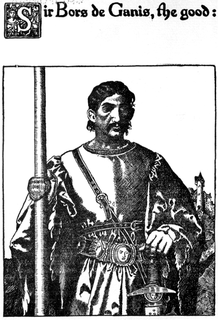 W
WBors is the name of two knights in Arthurian legend, an elder and a younger. The two first appear in the 13th-century Lancelot-Grail romance prose cycle. Bors the Elder is the King of Gaunnes (Gannes/Gaunes/Ganis) during the early period of King Arthur's reign, and is the brother of King Ban of Benoic and the father of Bors the Younger and Lionel. His son Bors the Younger later becomes one of the best Knights of the Round Table and participates in the achievement of the Holy Grail.
 W
WBrunor, Breunor, Branor or Brunero are various forms of a name given to several different characters in Arthurian legend. They include Knight of the Round Table known as Brunor/Breunor le Noir, as well as his father and others, among them another former knight of Uther's old Round Table and the father of Galehaut.
 W
WCaradoc Vreichvras was a semi-legendary ancestor to the kings of Gwent. He may have lived during the 5th or 6th century. He is remembered in the Matter of Britain as a Knight of the Round Table, under the names King Carados and Carados Briefbras.
 W
WSir Dinadan is a Knight of the Round Table in the Arthurian legend's chivalric romance tradition, appearing in the Prose Tristan and its adaptations including a part of Le Morte d'Arthur. Best known for his humor and pragmatism, Dinadan is a close friend of the protagonist Tristan.
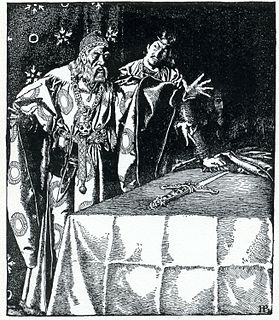 W
WSir Ector, sometimes Hector, Antor, or Ectorius, is the father of Sir Kay and the adoptive father of King Arthur in the Matter of Britain. Sometimes portrayed as a king instead of merely a lord, he has an estate in the country as well as properties in London.
 W
WFeirefiz is a character in Wolfram von Eschenbach's Arthurian poem Parzival. He is the half-brother of Parzival, the story's hero. He is the child of their father Gahmuret's first marriage to the Moorish queen Belacane, and equals his brother in knightly ability. Because his father was white and his mother black, Feirefiz's skin consists of black and white patches. His appearance is compared to that of a magpie or a parchment with writing on it, though he is considered very handsome.
 W
WGaheris or Gaheries is a character in the Arthurian legend, a nephew of King Arthur and a knight of the Round Table, the third son of Arthur's sister or half-sister Morgause and her husband Lot, King of Orkney and Lothian. He is the younger brother of Gawain and Agravain, and the older brother of Gareth and half-brother of Mordred. In Thomas Malory's popular Le Morte d'Arthur, Gaheris is little more than a supporting character to Gawain and Gareth, with the murder of Morgause an odd exception, but his role is greater in the French prose cycles. Later, he and Gareth are both killed by Lancelot during his rescue of Guinevere. A different knight known as Gaheris of Karaheu also appears in the legend.
 W
WSir Galahad among other versions of his name, is a knight of King Arthur's Round Table and one of the three achievers of the Holy Grail in Arthurian legend. He is the illegitimate son of Sir Lancelot and Elaine of Corbenic, and is renowned for his gallantry and purity as the most perfect of all knights. Emerging quite late in the medieval Arthurian tradition, Sir Galahad first appears in the Lancelot–Grail cycle, and his story is taken up in later works such as the Post-Vulgate Cycle and Sir Thomas Malory's Le Morte d'Arthur. His name should not be mistaken with Galehaut, a different knight from Arthurian legend.
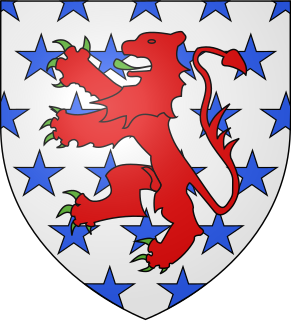 W
WGalehaut is a very tall knight in the Arthurian legend. He is most prominent within the Lancelot-Grail prose cycle where he is a noble enemy turned an ally of King Arthur as well as an inseparable friend of Arthur's champion Lancelot. The figure of Galehaut should not be mistaken with Lancelot's son, Galahad, and some other similarly named characters.
 W
WSir Gareth is a Knight of the Round Table in Arthurian legend. He was the youngest son of King Lot and Queen Morgause, King Arthur's half-sister, thus making him Arthur's nephew, as well as brother to Gawain, Agravain, and Gaheris, and either a brother or half-brother of Mordred. He is particularly notable in Le Morte d'Arthur where he is also known by his nickname Beaumains.
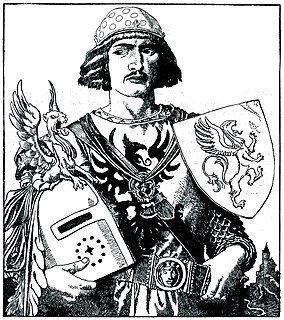 W
WGawain, also known as Gawaine or Gauwaine, among various other forms and spellings, is King Arthur's nephew and a Knight of the Round Table in Arthurian legend. He is mentioned under the name Gwalchmei in some of the earliest Welsh Arthurian sources. As Gawain and related variants, he appears in many Welsh, Latin, French, English, Scottish, Dutch, German, Spanish and Italian texts, notably as the protagonist of the famous Middle English story Sir Gawain and the Green Knight. Other tales featuring Gawain as the central character include De Ortu Waluuanii, Diu Crône, The Awntyrs off Arthure, Ywain and Gawain, Golagros and Gawane, L'âtre périlleux, Le Chevalier à l'épée, The Greene Knight, and The Weddynge of Syr Gawen and Dame Ragnell.
 W
WGeraint is a character from Welsh folklore and Arthurian legend. He was a king of Dumnonia and a valiant warrior. He may have lived during or shortly prior to the reign of the historical Arthur, although some scholars doubt he existed. The name Geraint is a Welsh form of the Latin Gerontius, meaning "old man".
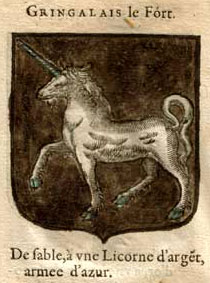 W
WSir Gingalain, also known as Le Bel Inconnu, or The Fair Unknown, is a character from Arthurian legend whose exploits are recorded in numerous versions of a popular medieval romance. His nickname differs depending on the version and language; he is known in English as Libeaus Desconus. He is the title character in Le Bel Inconnu, a poem composed by Renaut de Beaujeu sometime between the mid-1180s and 1230, and in the (destroyed) 13-century manuscript, Gliglois. It is uncertain, however, if the Gliglois of the medieval manuscript refers to Gawain's son or some other character in the "Fair Unknown" cycle.
 W
WThe Green Knight is a character from the 14th-century Arthurian poem Sir Gawain and the Green Knight and the related medieval work The Greene Knight. His true name is revealed to be Bertilak de Hautdesert in Sir Gawain, while The Greene Knight names him "Bredbeddle". The Green Knight later features as one of Arthur's greatest champions in the fragmentary ballad "King Arthur and King Cornwall", again with the name "Bredbeddle". In Sir Gawain and the Green Knight, Bertilak is transformed into the Green Knight by Morgan le Fay, a traditional adversary of King Arthur, in order to test his court. In The Greene Knight he is transformed by a different woman for the same purpose. In both stories he sends his wife to seduce Gawain as a further test. "King Arthur and King Cornwall" portrays him as an exorcist and one of the most powerful knights of Arthur's court.
 W
WKing Hoel, also known as Sir Howel and Saint Hywel, was a late 5th- and early 6th-century member of the ruling dynasty of Cornouaille. He may have ruled Cornouaille jointly after the restoration of his father, Budic II of Brittany, but he seems to have predeceased his father and left his young son, Tewdwr, as Budic's heir.
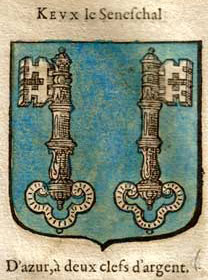 W
WIn Arthurian legend, Sir Kay is King Arthur's foster brother and later seneschal, as well as one of the first Knights of the Round Table. In later literature he is known for his acid tongue and bullying, boorish behaviour, but in earlier accounts he was one of Arthur's premier warriors. Along with Bedivere, with whom he is frequently associated, Kay is one of the earliest characters associated with Arthur. Kay's father is called Ector in later literature, but the Welsh accounts name him as Cynyr Ceinfarfog.
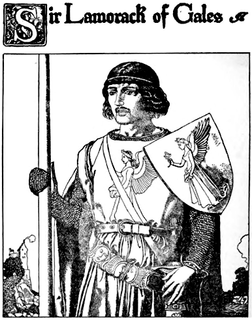 W
WSir Lamorak is a Knight of the Round Table in Arthurian legend. Introduced in the Prose Tristan, Lamorak reappears in later works including the Post-Vulgate Cycle and Thomas Malory's compilation Le Morte d'Arthur. Malory refers to him as Arthur's third best knight, only inferior to Lancelot and Tristan, but Lamorak was not exceptionally popular in the romance tradition, confined to the cyclical material and subordinate to more prominent characters.
 W
WLancelot du Lac, also written as Launcelot and other variants, is a character in some versions of Arthurian legend, where he is typically depicted as King Arthur's close companion and one of the greatest Knights of the Round Table. In the French-inspired Arthurian chivalric romance tradition, Lancelot is the orphaned son of King Ban of the lost kingdom of Benwick, raised in the fairy realm by the Lady of the Lake. A hero of many battles, quests and tournaments, and famed as a nearly unrivalled swordsman and jouster, Lancelot becomes the lord of Joyous Gard and personal champion of Arthur's wife Queen Guinevere. But when his adulterous affair with Guinevere is discovered, it causes a civil war that is exploited by Mordred to end Arthur's kingdom.
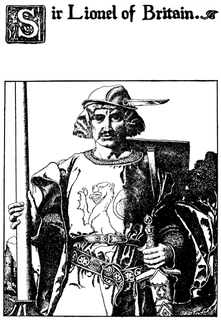 W
WSir Lionel is the younger son of King Bors of Gaunnes and Evaine and brother of Bors the Younger in Arthurian legend since the Lancelot-Grail cycle. He is a double cousin of Lancelot and cousin of Lancelot's younger half-brother Hector de Maris. He later became the subject of one of the famous Child Ballads (#18).
 W
WMordred or Modred is a figure who is variously portrayed in the British tradition. The earliest known mention of a possibly historical Medraut is in the Welsh chronicle Annales Cambriae, wherein he and Arthur are ambiguously associated with the Battle of Camlann in a brief entry for the year 537. His figure seemed to have been regarded positively in the early Welsh tradition and may have been related to that of Arthur's son.
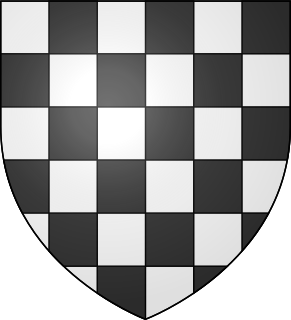 W
WPalamedes is a Knight of the Round Table in the Arthurian legend. He is a Saracen pagan who converts to Christianity later in his life, and his unrequited love for Iseult brings him into frequent conflict with Tristan. Palamedes' father is King Esclabor. His brothers, Safir and Segwarides, also join the Round Table. The romance Palamedes was named after him.
 W
WPelleas, or Pellias, is an Arthurian Knight of the Round Table whose story first appears in the Post-Vulgate Cycle. He becomes the husband of Nimue, the Lady of the Lake in Le Morte d'Arthur. Pelleas should not be confused with the character of Pelles, the Fisher King.
 W
WPercival —or Peredur, Perceval, Parzival, Parsifal but also Par·Oz or Parival — was one of King Arthur's legendary Knights of the Round Table. First made famous by the French author Chretien de Troyes in the tale Perceval, the Story of the Grail, he is best known for being the original hero in the quest for the Grail, before being replaced in later English and French literature by Galahad.
 W
WSir Sagramore is a Knight of the Round Table in the Arthurian legend. He appears in standalone and cyclical chivalric romances and other works, including some where he is the titular protagonist. Sagramore's characterisation varies from story to story, but generally he is characterised as a virtuous but hot-tempered knight who fights fiercely and ragefully. He gains a number of nicknames, including "the Hothead" and "the Desirous".
 W
WTristan, also known as Tristram or Tristain and similar names, is the hero of the legend of Tristan and Iseult, a story of mis-directed love.
 W
WUrien, often referred to as Urien Rheged or Uriens, was a late 6th-century king of Rheged, an early British kingdom of the Hen Ogledd. His power and his victories, including the battles of Gwen Ystrad and Alt Clut Ford, are celebrated in the praise poems to him by Taliesin, preserved in the Book of Taliesin. He became the "King Urien of Gorre" of later Arthurian legend and his son Owain mab Urien was later known as Ywain.
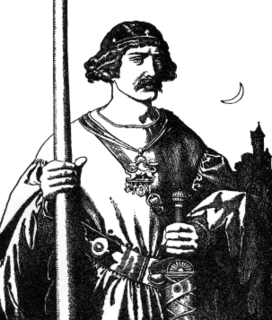 W
WSir Ywain, also known as Yvain, Owain, Uwain(e), Ewaine, Iwain, Iwein, etc., is a Knight of the Round Table in Arthurian legend, wherein he is often the son of King Urien of Gorre and the sorceress Morgan le Fay. The historical Owain mab Urien, on whom the literary character is based, was the king of Rheged in Great Britain during the late 6th century.